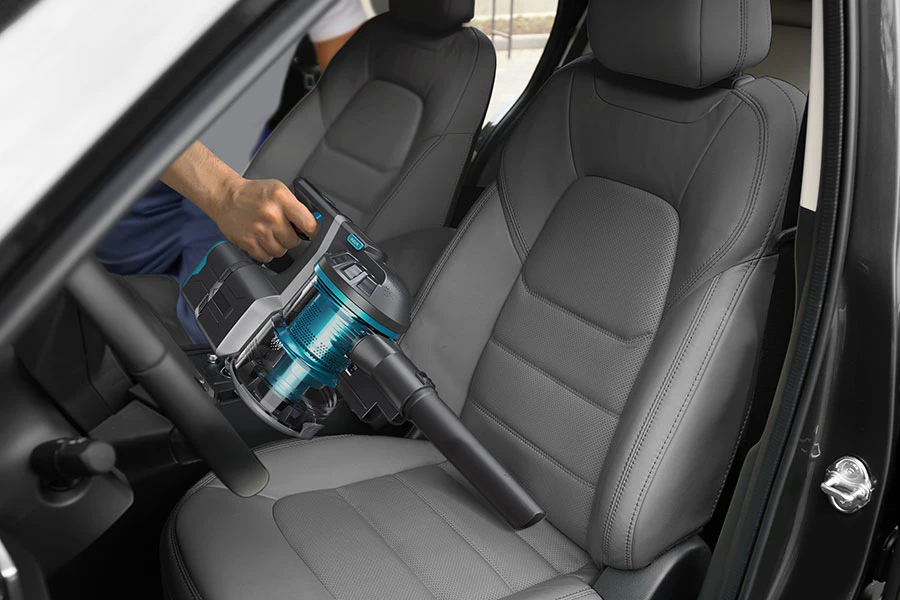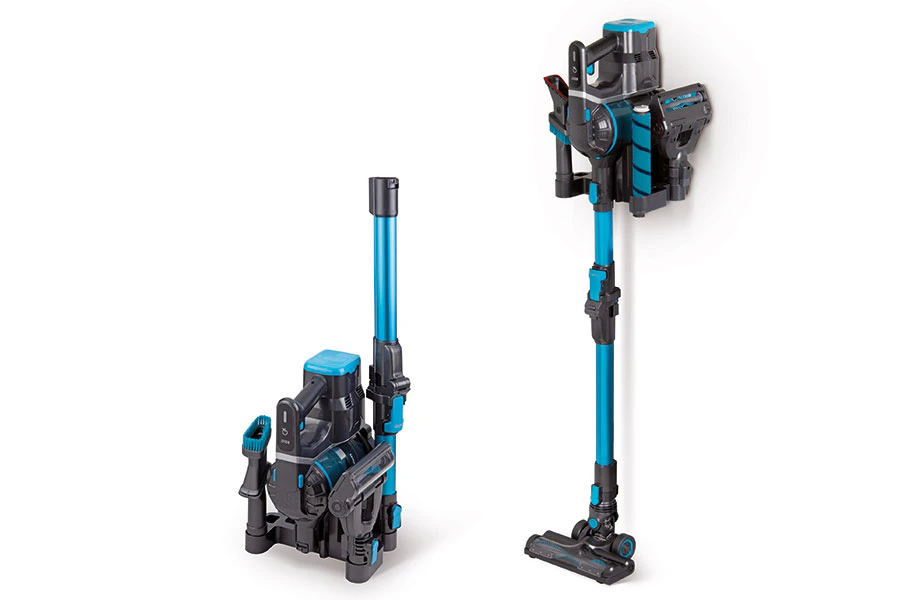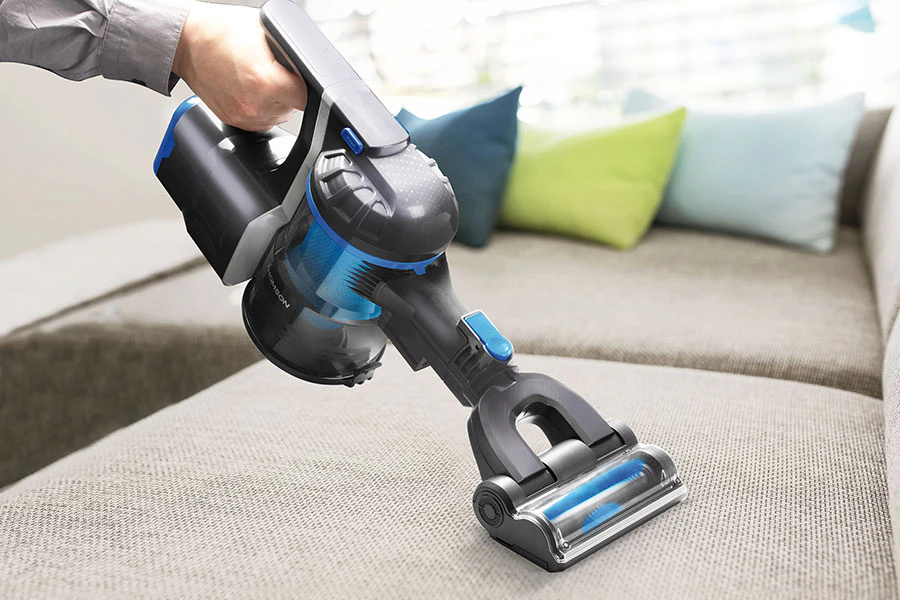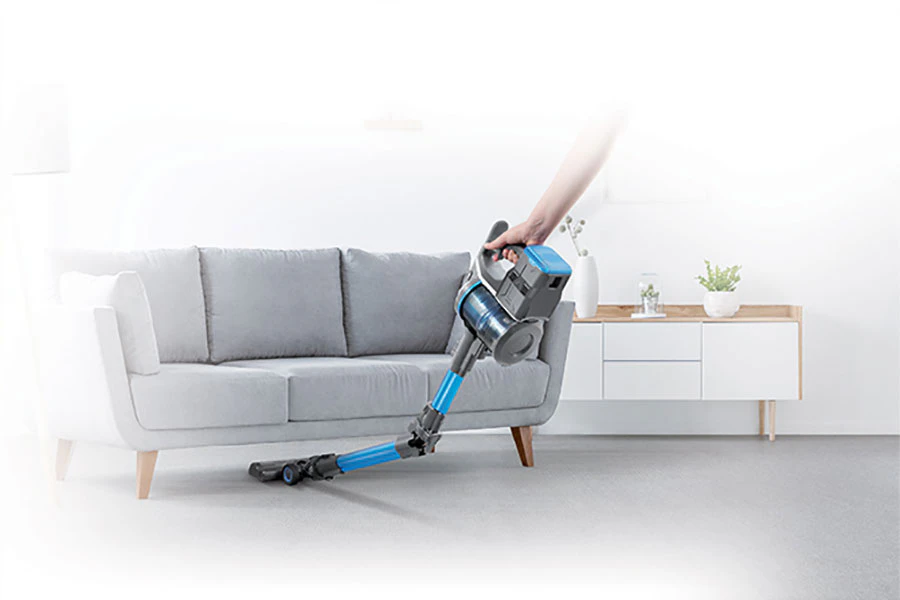
How does a vacuum cleaner work?
• Conventional technology
In a conventional vacuum cleaner with a bag, the air is sucked in by a motor, much like the back of a fan. At the level of the brush, the dust is loosened by the suction. This dust-laden air then passes through the pipe and arrives in the bag. As the latter is porous, it acts like a large filter. Thus, the dust is retained, while the air continues its path towards the engine. Depending on the vacuum cleaner model, a number of additional filters placed in the path trap any dust that is small enough to pass through the bag. It is effective, but the system has many drawbacks: loss of power when the bag fills up, the need to change it regularly and the progressive clogging of the engine because some microscopic dust always manages to slip through.
• Cyclonic technology
Popularized by the English Dyson brand and inspired by machines used to vacuum sawdust in industrial sawmills, cyclonic suction separates air from dust differently.
In a cyclonic vacuum cleaner, air is sucked through a kind of funnel, which creates a small cyclone. As with a natural cyclone, this air trapped in the vacuum cleaner spins at high speed and rises in a spiral, creating a suction effect. As the dust is heavier than air, once it reaches the top of the cyclone, it falls on the sides, in the vacuum cleaner tank. On the rest of the air path, there are other filters, again intended to get rid of dust grains that would have managed to escape the first operation. In addition to conventional dust filters, there are also models equipped with HEPA filters. These high efficiency filters are particularly recommended for people with allergies. There are also multi-cyclonic vacuum cleaners. In this case, the air passes through several additional cyclones for even more efficiency, but the principle remains the same.
Advantages of cyclonic technology
• Bagless
Cyclonic technology cannot be done through a traditional dust bag. Cyclonic vacuum cleaners therefore store dust in a tank.
Originally, the idea was to avoid the loss of power associated with filling the bag, but besides this immediate benefit there are other advantages. The first consequence of the absence of a bag is a small saving since there is no longer any need to change them, nor having to stock them in advance. On the other hand, when you accidentally suck up a small object, it is also much easier to retrieve it.
• More compact
Cyclone technology is much more efficient, since the bag does not obstruct the air flow. Cyclonic vacuum cleaners are equipped with digital motors having the characteristic of enabling high rotation speeds, since it is this which determines the suction power performances. The result is smaller, lighter engines that consume less energy.
Eventually design of vacuum cleaners was therefore completely revised and cyclonic vacuum cleaners are in many ways far different from their ancestors ... and much lighter.
Thanks to the compactness of components, no need to place the motor in a bulky sled as was the case with previous generations of vacuum cleaners. In the cyclonic vacuum cleaner-type models, the digital motor is so compact that it is placed in the extension of the handle. This is also where the tank of the brush-type vacuum cleaners is located. As practical as a hand-held vacuum cleaner, these cyclonic vacuum cleaners are thus very well balanced and easy to handle.
Another advantage is that this low weight and the compact size make it possible to vacuum at height if necessary. For dusting upholstery or curtains, it is very practical. There are also cyclonic sled vacuum cleaners, but for these models too, lightness and compactness are essential. Unlike cyclonic stick vacuum cleaners, which have a dust container of around 0.7 liters, these cyclonic sled vacuum cleaners have a dust container of one liter or more.
• Cordless
The digital motors used by cyclonic vacuum cleaners consume much less energy than those of traditional vacuum cleaners. As a result, these appliances can operate on battery power. When cleaning, you no longer need to connect to the mains, change plugs or use an extension cord because the cable is (still) too short. No more cumbersome cable dragging, jamming or dropping objects. Moreover, far easier to access difficult or higher located places.


• Storage
Once the cleaning is done, cyclonic stick vacuum cleaners are easily stored. A narrow cupboard or a corner of the wall is sufficient to store the appliance. On some models, there is a base or a wall bracket that acts as a charger. Depending on the device, charging the battery takes two to five hours and provides up to an hour of battery life.
• Ergonomics
Easy storage is also the guarantee of immediate operation: you grab the vacuum cleaner by the handle and just go and start. In addition, for even greater ease of use, cyclonic vacuums are often equipped with a trigger. It allows you to constantly adjust the power of the suction, in order to adapt instantly to all types of surfaces without having to stop.
Very practical also, some models of cyclonic vacuum cleaners have a tube that can be folded to go under a sofa, bed, etc. You can also reduce its length, transforming the device into a hand-held vacuum cleaner. The operation is done easily and several positions are provided to adapt to all situations. On this same model, there is also a motorized brush equipped with LED light, in order to flush out dust everywhere, even in dark corners.
• Robustness
The digital motors that equip cyclonic vacuum cleaners benefit from a design that makes them more resistant, directly derived from the technology used for computer hard disks. They are also supported by various sophisticated electronic components. But what probably contributes the most to their longevity is on the one hand the virtual absence of clogging due to dust and on the other hand by the absence of a bag. In a cyclonic vacuum cleaner, the motor does not have to work in overspeed as it is when a conventional vacuum cleaner tries to suck air through a full bag. Likewise, the presence of a speed adjustment trigger also allows the engine to rest since the speed is changed easily.
Accessories
Cyclonic or not, available accessories greatly contribute to the efficiency of these appliances. For cyclonic vacuum cleaners, we have the usual accessories but also , on top of them, new ones. In order to guarantee the compactness of the vacuum cleaner, they are stored separately, in particular on the charging base for certain models.
• Sucking nozzles
Squeegee nozzles of various lengths are designed to clean hard-to-reach places such as in very narrow spaces or between parquet boards. Smaller models are also great for cleaning computer keyboards.
• Soft brushes
There are different types of soft brushes, straight or rounded, intended for dusting fragile surfaces, such as furniture or screens.
• Electric brushes
Specific to cyclonic vacuum cleaners, the electric brush is motorized. The rotation of the brushes that compose it facilitates the removal of dust and is an important component of the efficiency of cyclonic suction. Depending on the model, the rotation can be interrupted on demand. This type of brush is often equipped with small LED bulbs. Far from being a gadget, it is a very practical addition, especially to reach under and behind furniture.
• Animal hair
The rotating brushes are also suitable for getting rid of animal hair, on the floor as well as on armchairs, sofas or upholstery.
• Clothes brush
Brushes intended for clothes can be easily recognized by a small red surface made up of a fabric that catches dust.
• Car kits
Supplied as standard accessories or optional, depending on the manufacturer, there are also kits specially designed for cleaning vehicles. There are nozzles and brushes, but specially designed for the interior of cars. In particular, the width of the brushes and electric brushes is reduced in order to reach everywhere inside of a car.


 Denmark (Danish)
Denmark (Danish)  Deutschland (Deutsch)
Deutschland (Deutsch)  España (Español)
España (Español)  France (Français)
France (Français)  Italia (Italiano)
Italia (Italiano)  Nederlands (Dutch)
Nederlands (Dutch)  Polska (Polski)
Polska (Polski)  Russia (Russian)
Russia (Russian)  Sweden (Swedish)
Sweden (Swedish)  Turkey (Turkish)
Turkey (Turkish)  Ukraine (English)
Ukraine (English)  United Kingdom (English)
United Kingdom (English)  USA (English)
USA (English)  China (Chinese)
China (Chinese)  Hong Kong (English)
Hong Kong (English)  India (English)
India (English)  Indonesia (English)
Indonesia (English)  Lebanon (English)
Lebanon (English)  Saudi Arabia (English)
Saudi Arabia (English)  Thailand (English)
Thailand (English)  Vietnam (English)
Vietnam (English)  Algeria (Français)
Algeria (Français)  Egypt (English)
Egypt (English)  Australia (English)
Australia (English)